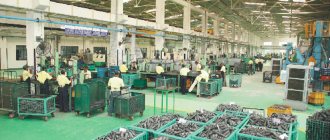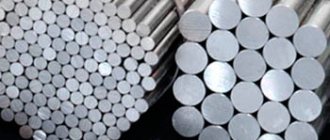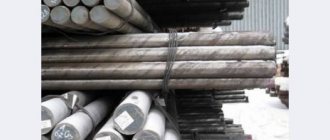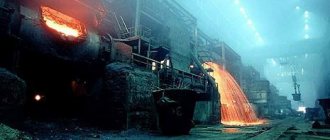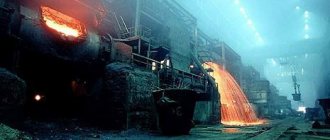Steel 70G Steel 60S2KhFA Steel 60KhFA (60KhF) Steel 65 Steel 65G (65G1) Steel 65GA Steel 65S2VA Steel 68A Steel 68GA Steel 70 Steel 60S2KhG Steel 70G2 Steel 70S2KhA (EI142) Steel 70S3A Steel 70KhGFA Steel 75 Steel 80 Steel 85 Steel KT-2 Steel KT-3 Steel 55S2A Steel 3K-7 Steel 40R Steel 50RA (50R) Steel 50KhG Steel 50KhGA Steel 50KhGFA Steel 50KhFA (50KhF) Steel 51KhFA Steel 55S2 Steel 60S2Х (60S2ХА; 60С2ХА) Steel 55S2ГФ Steel 55 HGR Steel 55HFA (55ХФ) Steel 60G Steel 60S2 Steel 60S2A Steel 60S2G Steel 60S2N2A
Description
Steel 70 is used : for the production of springs, springs and other parts that require increased strength and elastic properties, as well as wear resistance; wire of square, rectangular and trapezoidal sections, intended for the manufacture of spring washers; knives of earth-moving machines (bulldozers, scrapers, graders and motor graders, as well as for knives of bulldozer and grader equipment of excavators, rollers and other earth-moving machines); cold-rolled heat-treated tape with a thickness of 0.05−1.30 mm and flattened heat-treated tape with a thickness of 0.15−2.00 mm for the manufacture of spring parts and springs, with the exception of winding ones; hardened and tempered carded wire of round and shaped profiles, used for the manufacture of brackets for needle products; wire of square, rectangular and trapezoidal sections, intended for the manufacture of spring washers; tinned wire intended for the manufacture of rotor bands for electrical machines.
Note
Carbon spring steel.
Explanation of 70x16mfs markings and properties
- The first number is the carbon content in hundredths of a percent . The alloy of this brand contains 0.7% carbon - high hardness, characteristic dark matte color.
- X16 – 0.16% chromium . Since the content of this metal exceeds 0.13, it is stainless steel.
- M - steel contains molybdenum : increased ductility, reduced hardening temperature, minimized deformation under mechanical stress.
- F – vanadium : increasing the sharpening life; due to the possibility of reducing grains, increasing the sharpness of the blade, minimizing the likelihood of nicks.
- C – silicon : resistance to unsaturated organic and inorganic acids, except hydrofluoric acid; uniform distribution of porosity. But. Making the blade brittle, reducing resistance to strong simultaneous mechanical impacts, plasticity under gradual pressure.
- Manganese (not indicated in the labeling) – increases anti-corrosion and bactericidal properties, reduces elasticity.
Hardness – 58-61 Hcr ; viscosity – 0.4-0.6 mJ ; average hardening temperature – 1045 °C . Depending on the uniformity of calcination and the cooling method, the parameters of hardness and viscosity can vary in the range of up to 3% . The characteristics of the material must be indicated on the product packaging.
Standards
| Name | Code | Standards |
| Long and shaped rolled products | B22 | GOST 1133-71, GOST 8278-83, GOST 8281-80, GOST 8282-83, GOST 8283-93, GOST 9234-74, GOST 11474-76, GOST 17152-89, GOST 2590-2006, GOST 2591-2006, GOST 2879-2006 |
| Fittings, components and parts of railway rolling stock | D55 | GOST 11530-93 |
| Sheets and strips | B33 | GOST 1577-93, GOST 4405-75, TU 14-1-417-72, TU 14-1-4516-88, TU 14-1-634-73 |
| Ribbons | B34 | GOST 2284-79, GOST 21996-76, GOST 21997-76, TU 14-4-101-87, TU 4-14-100-84, TU 14-1-3656-83, TU 14-4-100-84 , TU 14-4-149-72 |
| Low carbon steel wire | B71 | GOST 3875-83 |
| Medium and high carbon steel wire | B72 | GOST 7348-81, GOST 9124-85, GOST 9389-75, GOST 11850-72, GOST 26366-84, TU 14-178-110-89, TU 14-4-777-76, TU 14-171-35- 89 |
| Long and shaped rolled products | B32 | GOST 7417-75, GOST 7419-90, GOST 8559-75, GOST 8560-78, GOST 14955-77, GOST 14959-79, TU 14-1-2118-77, TU 14-1-666-73, TU 14 -11-245-88, TU 14-1-1271-75, TU 14-136-367-2008 |
| Sheets and strips | B23 | GOST 82-70, GOST 19903-74, GOST 19903-90 |
Chemical composition
| Standard | C | S | P | Mn | Cr | Si | Ni | Fe | Cu |
| GOST 17152-89 (ISO 7129-82 | 0.67-0.75 | ≤0.035 | ≤0.035 | 0.5-0.8 | ≤0.25 | 0.17-0.37 | ≤0.25 | Remainder | ≤0.2 |
| GOST 14959-79 | 0.67-0.75 | ≤0.035 | ≤0.035 | 0.5-0.8 | ≤0.25 | 0.17-0.37 | ≤0.25 | Remainder | ≤0.2 |
Fe is the basis.
Brand: steel, metal 70
Brand: 70
| Brand: | 70 |
| Substitute: | 65G |
| Classification: | Structural spring steel |
| Application: | springs, springs and other parts that require increased strength and elastic properties, as well as wear resistance. |
| Foreign analogues: |
| C | Si | Mn | Ni | S | P | Cr | Cu |
| 0.67 — 0.75 | 0.17 — 0.37 | 0.5 — 0.8 | up to 0.25 | up to 0.035 | up to 0.035 | up to 0.25 | up to 0.2 |
| Ac1 = 730, Ac3(Acm) = 743, Ar3(Arcm) = 727, Ar1 = 693 |
| Weldability: | not applicable to welded structures. |
| Flock Sensitivity: | insensitive. |
| Tendency to temper brittleness: | not inclined. |
| Assortment | Size | Eg. | sв | sT | d5 | y | KCU | Thermal change |
| — | mm | — | MPa | MPa | % | % | kJ/m2 | — |
| Rod, GOST 14959-79 | up to Ø 80 | 1030 | 834 | 9 | 30 | Quenching 830oC, oil, Tempering 470oC, |
| Cold-worked tape, GOST 2284-79 | 740-1130 |
| Annealed tape, GOST 2284-79 | 440-740 | 10 |
| Hardness 70 without heat treatment, GOST 14959 | HB 10 -1 = 269 MPa |
| Hardness 70 after annealing, thick sheet GOST 1577-93 | HB 10 -1 = 229 MPa |
| T | E 10- 5 | a 10 6 | l | r | C | R 10 9 |
| hail | MPa | 1/Grad | W/(m deg) | kg/m3 | J/(kg deg) | Ohm m |
| 20 | 2.06 | 7810 |
| 100 | 11.5 | 68 | 483 |
| 200 | 12.3 | 52 | 487 |
| 300 | 13 | 37 |
| 400 | 13.8 | 29 | 521 |
| T | E 10- 5 | a 10 6 | l | r | C | R 10 9 |
Foreign analogues of the material
Both exact and closest analogues are indicated!
| USA | Germany | Japan | France | England | European Union | Italy | China | Sweden | Bulgaria | Poland | Romania | Czech | Australia |
| — | DIN,WNr | JIS | AFNOR | B.S. | EN | UNI | G.B. | SS | BDS | PN | STAS | CSN | AS |
|
| 1070 |
| G10690 |
| G10700 |
| | | | | | Mechanical properties : | | sв | — Short-term strength limit, [MPa] | | sT | — Proportional limit (yield strength for permanent deformation), [MPa] | | d5 | — Elongation at break, [%] | | y | — Relative narrowing, [%] | | KCU | — Impact strength, [kJ/m2] | | HB | — Brinell hardness, [MPa] |
| Physical properties: | | T | — Temperature at which these properties were obtained, [Deg] | | E | — Modulus of elasticity of the first kind, [MPa] | | a | — Coefficient of thermal (linear) expansion (range 20o - T), [1/degree] | | l | — Thermal conductivity coefficient (heat capacity of the material), [W/(m deg)] | | r | — Material density, [kg/m3] | | C | — Specific heat capacity of the material (range 20o — T), [J/(kg deg)] | | R | — Electrical resistivity, [Ohm m] |
| Weldability: | | no limits | — welding is performed without heating and without subsequent heat treatment | | limited weldability | — welding is possible when heated to 100-120 degrees. and subsequent heat treatment | | difficult to weld | — to obtain high-quality welded joints, additional operations are required: heating to 200-300 degrees. during welding, heat treatment after welding - annealing |
|
|
|
|
|
|
Mechanical characteristics
| Section, mm | sТ|s0.2, MPa | σB, MPa | d5, % | d4 | y, % | Brinell hardness, MPa | HV, MPa |
| Cold rolled strip 0.1-4.0 mm in delivery condition according to GOST 2284-79 |
| — | — | 440-740 | — | ≥10 | — | — | — |
| — | — | 440-640 | — | ≥10 | — | — | — |
| — | — | 740-1130 | — | — | — | — | — |
| Long products. Normalization |
| ≤80 | ≥510 | ≥910 | ≥17 | — | ≥29 | ≥252 | — |
| Carded wire 0.2-0.8 mm in delivery condition according to GOST 3875-83 (samples) |
| — | — | 1960-2160 | — | — | — | — | — |
| — | — | 2161-2350 | — | — | — | — | — |
| Cold-rolled, heat-treated strip (0.05-1.30 mm) for spring parts and springs in accordance with GOST 21996-76 and flattened strip (0.15-2.00 mm) in accordance with GOST 21997-76 (strength group of the strip is indicated) |
| — | — | 1270-1570 | — | — | — | — | 375-485 |
| — | — | 1580-1860 | — | — | — | — | 486-600 |
| — | — | ≥1860 | — | — | — | — | ≥600 |
| Wire of square, rectangular and trapezoidal sections according to GOST 11850-72 |
| 0.6-12 | — | 590-780 | — | — | — | — | — |
| 0.6-12 | — | 490-780 | — | — | — | — | — |
| 0.6-3 | — | ≤1130 | — | — | — | — | — |
| 0.6-3 | — | ≤980 | — | — | — | — | — |
| 0.6-3 | — | ≤1230 | — | — | — | — | — |
| Wire. Quenching in oil from 920 °C (toil = 40 °C, holding time 1 min.) + Tempering at 500 °C (holding time 15 min.), cooling in air |
| ≤6.5 | — | ≥1240 | ≥7 | — | ≥47 | ≥315 | — |
| Long products. Steel categories: 3, 3A, 3B, 3B, 3G, 4, 4A, 4B. Quenching in oil from 830 °C + tempering at 470 °C |
| ≥835 | ≥1030 | ≥9 | — | ≥30 | — | — |
Spring steel 70
Analogs
Steel 65G.
Type of delivery
- Long products, including shaped steel: GOST 14959-79, GOST 2590-88, GOST 2591-88, GOST 2879-88, GOST 74190.0-90, GOST 7419.1-90, GOST 7419.3-90, GOST 7419.5-90 - GOST 7419.8 -90.
- Calibrated rod GOST 7417-75, GOST 8559-75, GOST 8560-78.
- Polished rod and silver GOST 14955-77, GOST 7419.0-90, GOST 7419.1-90, GOST 7419.3-90, GOST 7419.5-90 - GOST 7419.8-90.
- Thick sheet GOST 1577-93, GOST 19903-74.
- Tape GOST 1530-78, GOST 2284-79, GOST 21996-76, GOST 21997-76.
- Strip GOST 4405-75, GOST 74194-90, GOST 82-70, GOST 7419.2-90.
- Forgings and forged blanks GOST 1133-71.
- Wire GOST 9389-75.
Decoding
The number 70 means that the average carbon content in steel is 0.70%.
Characteristics and Application
Steel 70 is a structural spring-unalloyed special steel with high strength and elastic properties and is used for the manufacture of parts that require increased strength and elastic properties, wear resistance, parts operating under friction conditions in the presence of high static and vibration loads:
- lock washers
- clutch discs
- eccentrics
- spindles
- shims
- bandages
- crane wheels
Steel 70 is also used for the manufacture of springs and spring elements up to 12 mm thick; cylindrical and shaped springs with a diameter of up to 15 mm; small buffer springs. Cylindrical and shaped springs, cold wound from wire with a diameter of 0.14-8 mm, flat springs, cold deformed from a tape no more than 5 mm thick.
Temperature of critical points, °C
Chemical composition, % (GOST 14959-79)
| C | Mn | Si | Cr | Cu | Ni | P | S |
| no more |
| 0,67-0,75 | 0,50-0,80 | 0,17-0,37 | 0,25 | 0,20 | 0,25 | 0,035 | 0,035 |
Chemical composition, % (GOST 14959-2016)
| Mass fraction of elements, % |
| C | Si | Mn | Cr | V | W | Ni | B | Cu, no more |
| 0,67-0,75 | 0,17-0,37 | 0,50-0,80 | No more than 0.25 | — | — | No more than 0.25 | — | 0,20 |
NOTE. The sign “-” means that the mass fraction of the element is not standardized or controlled
Chemical composition of steel 70 intended for the production of patented wire (GOST 14959-2016)
| Mass fraction of elements, % |
| C | Si | Mn | Cr | Ni | Cu |
| No more |
| 0,67-0,75 | 0,17-0,37 | 0,30-0,60 | 0,15 | 0,15 | 0,20 |
Hardness of metal products as delivered (GOST 14959-2016)
| Hardness of metal products, HB, no more |
| categories 1B, 2B, 3B, 4B, 3G, 3D, 3E | heat treated (categories 1A, 2A, 3A, 3B, 4A) |
| 269 | 229 |
NOTE: When manufacturing metal products without heat treatment, deviations in hardness are allowed:
- for metal products in coils + 10 HB;
- for metal products strip +40 HB.
Heat treatment mode for steel 70 [1]
| Critical points, °C | Hardening, °C (in oil) | Holiday, °C |
| Ac1 | Ac3 |
| 730 | 743 | 830 | 470 |
Mechanical properties of metal products during tensile testing (GOST 14959-2016)
| Recommended mode of thermal treatment of samples | Mechanical properties, no less |
| Hardening | Vacation |
| Heating temperature, °C | Cooling medium | Heating temperature, °C | Cooling medium | Yield strength σt, N/mm2 | Tensile strength σв, N/mm2 | Relative elongation δ,% | Relative narrowing ψ, % |
| 830 | Oil | 470 | Air | 835 | 1030 | 9 | 30 |
NOTE:
- The mechanical properties of metal products during tensile testing are determined on longitudinal heat-treated samples.
- Heat treatment is carried out on samples intended for mechanical testing, with an allowance for grinding.
- During the recommended heat treatment, temperature deviations are allowed:
- holiday ±50 °C.
- Relative contraction rates are given only for round samples.
- The standards for mechanical properties apply to samples taken from metal products with a diameter or thickness of up to 80 mm inclusive. When testing metal products with a diameter or thickness of over 80 to 150 mm inclusive, it is allowed to reduce the relative elongation by 2% (abs.), the relative contraction by 5% (abs.) compared to the standards indicated in the table. When testing metal products with a diameter or thickness of more than 150 mm, it is allowed to reduce the relative elongation by 3% (abs.), the relative contraction by 10% (abs.) compared to the standards indicated in the table. The standards of mechanical properties of metal products with a diameter or thickness of more than 100 mm, when tested on samples made from rolled or forged workpieces with a square side of 90 to 100 mm, must correspond to the standards specified in the table.
Mechanical properties
| Source | Delivery status | Section, mm | σ0.2, MPa | σв, MPa | δ5 (δ4), % | ψ, % | Hardness HB, no more |
| no less |
| GOST 14959-79 | Steel categories: 3, 3A, 3B, 3B, 3G, 4, 4A, 4B. Hardening at 830°C in oil; tempering at 470°C. | Samples | 835 | 1030 | 9 | 30 | — |
| * | Normalization | — | 510 | 910 | 17 | 29 | 262 |
| ** | Wire. Quenching from 920°C in oil with a temperature of 40°C, holding time for 1 minute; tempering at 500°C, holding time 15 min | 6,5 | — | 1240 | 7 | 47 | 315 |
NOTE.
- Fatigue limit σ-1 = 466 MPa at n=106; hardening 830°C; tempering 550-600°С, σв = 840 MPa.
- *Tovpenets V.S., Zhukov A.I. Modes of hardening heat treatment of rolled products
- **Technological, physico-chemical and mechanical properties of steel / Sat. scientific tr./ Ed. V.P. Elutina
Technological properties
| Forging temperature, °C | start 1200, end 850. |
| Weldability | not applicable to welded structures. CTS followed by heat treatment. |
| Machinability | Kv tv.sp. = 0.7 and Kv b.st. = 0.6 at HB 183-241. |
| Flock sensitivity | insensitive. |
| Tendency to temper brittleness | not inclined. |
Density ρп kg/cm3 at test temperature, °С
Linear expansion coefficient α*106, K-1
| steel grade | α*106, K-1 at test temperature, °C |
| 20-100 | 20-200 | 20-300 | 20-400 |
| 70 | 11,5 | 12,3 | 13.0 | 13,8 |
Specific heat capacity c, J/(kg*K)
| steel grade | s, J/(kg*K), at test temperature, °C |
| 20-100 | 20-200 | 20-300 | 20-400 | 20-500 | 20-600 |
| 70 | 483 | 487 | — | 521 | — | 567 |
Thermal conductivity coefficient λ W/(m*K)
| Steel grade | λ W/(m*K), at test temperature, °C |
| 20 | 100 | 200 | 300 | 400 |
| 70 | — | 68 | 52 | 37 | 29 |
Young's modulus (normal elasticity) E, GPa
| Steel grade | At test temperature, °C |
| 20 |
| 70 | 206 |
Modulus of elasticity in torsional shear G, GPa
| steel grade | At test temperature, °C |
| 20 |
| 70 | 78 |
Bibliography
- Spring steels and alloys. Rachstadt (1982)
Find out more
Steel 5ХНМ tool stamping…
Structural alloy steel 40Х…
Steel X12F1 tool stamping...
Structural alloy steel 18ХГТ…
Description of mechanical symbols
| Name | Description |
| Section | Section |
| sT|s0.2 | Yield strength or proportional limit with tolerance for permanent deformation - 0.2% |
| σB | Short-term strength limit |
| d5 | Elongation after break |
| d4 | Elongation after break |
| y | Relative narrowing |
| H.V. | Vickers hardness |
physical characteristics
| Temperature | E, GPa | G, GPa | r, kg/m3 | l, W/(m °С) | a, 10-6 1/°С | C, J/(kg °C) |
| 0 | 206 | 78 | 7810 | — | — | — |
| 20 | 206 | — | 7810 | — | — | — |
| 100 | — | — | — | 68 | 115 | 483 |
| 200 | — | — | — | 52 | 123 | 483 |
| 300 | — | — | — | 37 | 13 | — |
| 400 | — | — | — | 29 | 13 | 487 |
| 600 | — | — | — | — | 138 | 521 |
| 800 | — | — | — | — | — | 567 |

